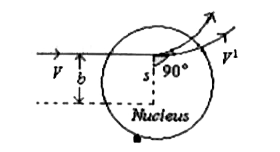A projectile of mass m, charge Z., initial speed v and impact parameter b is scattered by a heavy nucleus of charge Z. Use angular momentum and energy conservation to obtain a formula connecting the minimum distance (s) of the projectile form the nucleus to these parameters. Show that for b = 0, s reduces to the closest distance of approach r0.
Fig. shows the conditions of the problem.
Charge on the nucleus = Ze
Charge on the projectile = Z.e

At infinity, the angular momentum of projectile about the nucleus = mvb
When the projectile is at the minimum distance s from the nucleus, its velocity vector v. is normal to the radius vector (drawn from the centre of the nucleus).
∴ Angular momentum of the projectile about the nucleus = mv.s
From the law of conservation of angular momentum, we have,
mvb = mv.s or v.=vbs ____i
When the projectile is infinitely away from the nucleus, it has only kinetic energy (∵ P.E = 0) given by,
Ek=12mv2
When the projectile is at minimum distance s from the nucleus, it has both kinetic and potential energies given by,
Ek=12mv.2 and E.p=14πε0.ZZ.e2s
From the law of conservation of energy, we have,
Ek+Ep=Ek
or 12mv.2+14πε0.ZZ.e2s=12mv2
Putting v. = vb/s from eq. (i), we get,
12mv2b2s2+14πε0.ZZ.e2s=12mv2
Dividing both sides by mv2/2, we get,
b2s2+14πε0.ZZ.e2s(mv2/2)=1 or s2=b2+14πε0.ZZ.e2smv2/2
This is the required formula.
For a head-on collision, b = 0.
∴s2=14πε0.ZZ.e2smv2/2∴s=14πε0.ZZ.e2smv2/2
which is the distance of closest approach
Topper's Solved these Questions
- ATOMSBOOK - AAKASH SERIESCHAPTER - ATOMSEXERCISE - EXERCISE - I
21 Videos
- ATOMSBOOK - AAKASH SERIESCHAPTER - ATOMSEXERCISE - EXERCISE - II
19 Videos
- ATOMSBOOK - AAKASH SERIESCHAPTER - ATOMSEXERCISE - EXERCISE -III
25 Videos
- APPENDICES (REVISION EXERCISE)BOOK - AAKASH SERIESCHAPTER - APPENDICES (REVISION EXERCISE)EXERCISE - LAW OF MOTION
91 Videos
- CAPACITORS BOOK - AAKASH SERIESCHAPTER - CAPACITORS EXERCISE - PRACTICE SHEET (ADVANCED) (Integer Type Questions)
2 Videos
Similar Questions
A particle of mass m, charge q>0 and initial kinetic energy K is projected from infinity towards a heavy nucleus of charge Q assumed to have a fixed position.
(a) If the aim is perfect, how close to the centre of the nucleus is the particle when it comes instantaneously to rest ?
(b) With a particular imperfect aim, the particle's closest approach to nucleus is twicw the distance determined in (a). Determine speed of particle at the closest distance of approach.
View SolutionWhen an α particle of mass m moving with velocity v bombards on a heavy nucleus of charge Ze, its distance of closest approach form the nucleus depends on m as
View Solution
Knowledge Check
When an a-particle of mass 'm' moving with velocity 'v' bombards on a heavy nucleus of charge 'Ze', its distance of closest approach from the nucleus depends on v as:
A1vB1√vC1v2DvWhen an α particle of mass m moving with velocity v bombards on a heavy nucleus of charge Ze, its distance of closest approach form the nucleus depends on m as
A1mB1√mC1m2DmWhen an α particle of mass m moving with velocity v bombards on a heavy nucleus of charge Ze, its distance of closest approach form the nucleus depends on m as
A1√mB1m2CmD1m
When an α−particle of mass 'm' moving with velocity 'v' bombards on a heavy nucleus of charge 'Ze' its distance of closest approach from the nucleus depends on m as :
View SolutionWhen an α−particle of mass 'm' moving with velocity 'v' bombards on a heavy nucleus of charge 'Ze' its distance of closest approach from the nucleus depends on m as :
View SolutionA particle of mass m is moving along the line y=b,z=0 with constant speed v. State whether the angular momentum of particle about origin is increasing, decreasing or constant.
View SolutionA particle of mass m is moving along the line y=b,z=0 with constant speed v. State whether the angular momentum of particle about origin is increasing. Decreasing or constant.
View SolutionWhen an α−particle of mass 'm' moving with velocity 'v' bombards on a heavy nucleus of charge 'Ze' its distance of closest approach from the nucleus depends on m as :
View Solution
